Cardiac Researchers Use Stem Cells to Generate Functional Heart Muscle
By LabMedica International staff writers
Posted on 03 May 2016
Stem cell researchers have developed a new technique to form micro-scale arrays of engineered heart muscle (EHM) from fewer than 10,000 starter cells without requirement for adherence features or extracellular matrix (ECM).Posted on 03 May 2016
Tissue engineering approaches have the potential to increase the physiologic relevance of cells, such as cardiomyocytes, derived from human induced pluripotent stem cells (iPSCs). However, forming engineered heart muscle (EHM) typically requires more than one million cells per tissue. Existing miniaturization strategies involve complex approaches not suitable for mass production, limiting the ability to use EHM for iPSC-based disease modeling and drug screening. Microscale cardiospheres are easily produced, but do not facilitate assembly of elongated muscle or direct force measurements.
Investigators at the Gladstone Institute (San Francisco, CA, USA) recently described a new approach for preparing EHM that dramatically reduced the number of cells needed, making it an easier, cheaper, and more efficient system.
Initially, the investigators generated heart muscle cells and connective tissue cells from iPSCs. They then cultured combinations of these cells in a special vessel that resembled a tiny dog bone. This unique shape encouraged the cells to self-organize into elongated muscle fibers. Within a few days, the micro tissues resembled heart muscle both structurally and functionally.
The EHM prepared by this method exhibited uniaxial contractility and alignment, robust sarcomere assembly, and reduced variability and hypersensitivity in drug responsiveness compared to monolayers with the same cellular composition.
“The beauty of this technique is that it is very easy and robust, but it still allows you to create three-dimensional miniature tissues that function like normal tissues,” said senior author Dr. Bruce Conklin, senior investigator of cardiovascular disease at the Gladstone Institute. “Our research shows that you can create these complex tissues with a simple template that exploits the inherent properties of these cells to self-organize. We think that the micro heart muscle will provide a superior resource for conducting research and developing therapies for heart disease.”
Related Links:
Gladstone Institute














